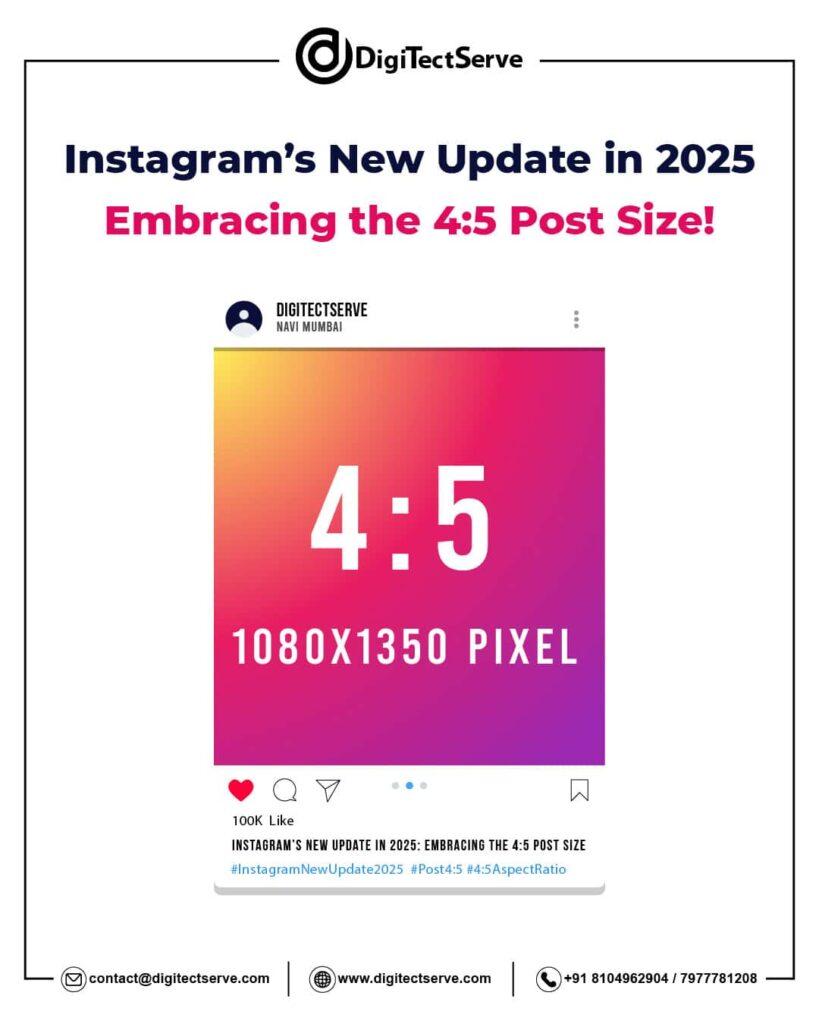Instagram’s New Update in 2025: Embracing the 4:5 Post Size!
Instagram’s new 4:5 post size update!

Instagram has once again taken a step forward in redefining how we share and consume content on its platform. In its latest 2025 update, the platform emphasizes the 4:5 aspect ratio for posts, aiming to optimize user experience and keep up with the evolving digital landscape. This change is significant for creators, businesses, and casual users alike, as it impacts content creation strategies and audience engagement.
In this blog, we’ll explore the details of Instagram’s new 4:5 post size update, its implications for users, and how to adapt to this change effectively.
1. Understanding the 4:5 Aspect Ratio:
The 4:5 aspect ratio refers to a vertical rectangle where the width is 80% of the height. This format is taller than the traditional square (1:1) but shorter than the full-screen vertical (9:16) dimensions used for Reels and Stories. The dimensions for 4:5 posts are typically 1080 pixels wide by 1350 pixels tall, making it ideal for mobile-first viewing.
2. Why Instagram Focuses on 4:5 Post Size
Instagram’s emphasis on the 4:5 post size isn’t arbitrary. The decision is rooted in the platform’s mission to enhance visual storytelling and adapt to user preferences. Here are the main reasons:
1. Mobile Optimization:
With over 90% of Instagram users accessing the platform via mobile devices, the 4:5 aspect ratio maximizes screen real estate without overwhelming the viewer. It strikes a balance between visibility and aesthetics, ensuring content looks appealing on all screen sizes.
2. Improved Engagement:
Vertical content naturally draws more attention, as it takes up more space on the feed. Posts in the 4:5 ratio are more likely to capture a viewer’s attention compared to square or horizontal posts.
3. A Unified Experience:
By standardizing the 4:5 aspect ratio for feed posts, Instagram creates a cohesive experience across different content formats, including carousels and Reels.
4. Alignment with Creator Trends:
Content creators and influencers often prefer vertical formats because they’re better suited for storytelling. The 4:5 ratio allows creators to share visually compelling content while maintaining high engagement rates.
3.Benefits of Using the 4:5 Aspect Ratio
Adapting to the 4:5 aspect ratio offers several advantages for both creators and businesses:
1. Enhanced Visual Appeal:
The taller format provides more space to showcase details in photos and videos, making it ideal for storytelling, portraits, and product displays.
2. Better Discoverability:
Content that takes up more screen space is more likely to be noticed, increasing the chances of likes, comments, and shares.
3. Improved Ad Performance:
For advertisers, 4:5 ads deliver higher engagement rates as they appear larger and more prominent on users’ feeds.
4. Seamless Carousel Experience:
Carousels with 4:5 images or videos create a more cohesive and immersive viewing experience, encouraging users to swipe through all slides.
To make the most of Instagram’s 2025 update, creators and businesses must adjust their content strategies. Here’s how:
1. Adjust Your Content Creation Process:
Use cameras or smartphones that support vertical shooting modes.
Edit your images and videos to fit the 4:5 aspect ratio (1080×1350 pixels).
Leverage tools like Adobe Photoshop, Canva, or Lightroom to crop and optimize visuals.
2. Update Your Content Strategy:
Focus on creating visually impactful posts that take advantage of the larger vertical space.
Highlight key elements such as faces, text, or products within the 4:5 frame.
3. Test Different Formats:
Experiment with single-image posts, carousels, and videos to identify what resonates best with your audience.
A/B test various creative styles to optimize engagement.
4. Use Instagram Insights:
Analyze performance metrics for your 4:5 posts to understand their impact on reach and engagement.
Use this data to refine your content strategy over time.
5. Educate Your Team:
If you’re a business or agency, ensure your team is aware of the new guidelines and trained to create optimized content.
If you’re wondering how to leverage the new format creatively, here are some ideas:
1. Behind-the-Scenes Content:
Share vertical shots of your workspace, team activities, or product development process.
2. Tutorials and How-To Guides:
Create step-by-step visual guides tailored for the 4:5 format to educate your audience.
3. Infographics:
Design eye-catching infographics that take advantage of the vertical space to deliver information effectively.
4. Product Highlights:
Showcase your products with detailed visuals and include compelling captions to drive sales.
5. User-Generated Content:
Feature testimonials, reviews, or photos from your audience in the 4:5 format to build trust and community.
While the 4:5 update offers many benefits, it also presents challenges for some users. Here’s how to address them:
1. Content Cropping Issues:
Challenge: Existing photos and videos may not fit the 4:5 ratio, leading to awkward crops.
Solution: Use editing tools to reframe your content or add borders to fit the desired dimensions.
2. Increased Production Time:
Challenge: Creating vertical content may require more planning and effort.
Solution: Develop templates and workflows to streamline your content creation process.
3. Audience Adaptation:
Challenge: Your audience may take time to adjust to the new format.
Solution: Communicate the benefits of the new format through captions and engaging storytelling.
To ensure your posts align with Instagram’s updated guidelines, consider using these tools:
Canva: For designing graphics and layouts in the 4:5 format.
Adobe Lightroom: For photo editing and cropping.
Final Cut Pro/Adobe Premiere Pro: For editing vertical videos.
InShot: A mobile-friendly app for quick video edits.
Snapseed: For touch-ups and enhancements on photos.
Instagram’s move toward the 4:5 aspect ratio reflects a broader trend in social media toward mobile-first design. Here’s what we can expect in the future:
Increased Vertical Content Across Platforms
Other platforms may follow suit, emphasizing vertical formats for better mobile compatibility.
Higher Content Quality Standards
As visual storytelling becomes more important, the demand for professional-quality content will grow.
Enhanced Creator Tools
Instagram and third-party apps may introduce new features to simplify vertical content creation.







